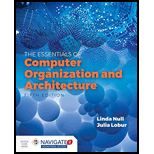
a)
Explanation of Solution
Converting “100001.111” to decimal equivalent:
Step 1: First separate the given binary fractions into two parts, left binary part and right binary fractions.
Step 2: To convert the binary fraction into decimal number, multiply the left part of the binary number with the positive integers for base 2.
Step 3: Multiply the right part of the binary number with the negative integers for base 2.
Step 4: Add all the values to get the final result.
100001.111 =1x25+0x24+0x23+0x22+0x21+1x20+1x2−1+1x2−2+1x2−3=32+0+0+0+0+1+0.5+0.25+0.125=33.875
Thus, the decimal equivalent of 100001.111 is “33.87510”.
b)
Explanation of Solution
Converting “111111.10011” to decimal equivalent:
Step 1: First separate the given binary fractions into two parts, left binary part and right binary fractions.
Step 2: To convert the binary fraction into decimal number, multiply the left part of the binary number with the positive integers for base 2.
Step 3: Multiply the right part of the binary number with the negative integers for base 2.
Step 4: Add all the values to get the final result.
111111.10011 =1x25+1x24+1x23+1x22+1x21+1x20+1x2−1+0x2−2+0x2−3+1x2−4+1x2−5=32+16+8+4+2+1+0.5+0+0+0.0625+0.03125=63.59375
Thus, the decimal equivalent of 111111.10011 is “63.5937510”.
c)
Explanation of Solution
Converting “1001100.1011” to decimal equivalent:
Step 1: First separate the given binary fractions into two parts, left binary part and right binary fractions.
Step 2: To convert the binary fraction into decimal number, multiply the left part of the binary number with the positive integers for base 2.
Step 3: Multiply the right part of the binary number with the negative integers for base 2.
Step 4: Add all the values to get the final result.
1001100.1011=1x26+0x25+0x24+1x23+1x22+0x21+0x20+1x2−1+0x2−2+1x2−3+1x2−4 =64+0+0+8+4+0+0+0.5+0+0.125+0.0625 =76.6875
Thus, the decimal equivalent of 1001100.1011 is “76.687510”.
d)
Explanation of Solution
Converting “10001001.0111” to decimal equivalent:
Step 1: First separate the given binary fractions into two parts, left binary part and right binary fractions.
Step 2: To convert the binary fraction into decimal number, multiply the left part of the binary number with the positive integers for base 2.
Step 3: Multiply the right part of the binary number with the negative integers for base 2.
Step 4: Add all the values to get the final result.
10001001.0111=1x27+0x26+0x25+0x24+1x23+0x22+0x21+1x20+0x2−1+1x2−2+1x2−3+1x2−4 =128+0+0+0+8+0+0+1+0+0.25+0.125+0.0625 =137.4375
Thus, the decimal equivalent of 10001001.0111 is “137.437510”.
Want to see more full solutions like this?
Chapter 2 Solutions
Essentials of Computer Organization and Architecture
- Please solve and answer the questions correctly please. Thank you!!arrow_forwardConsidering the TM example of binary sum ( see attached)do the step-by-step of execution for the binary numbers 1101 and 11. Feel free to use the Formal Language Editor Tool to execute it; Write it down the current state of the tape (including the head position) and indicate the current state of the TM at each step.arrow_forwardI need help on inculding additonal code where I can can do the opposite code of MatLab, where the function of t that I enter becomes the result of F(t), in other words, turning the time-domain f(t) into the frequency-domain function F(s):arrow_forward
 Database System ConceptsComputer ScienceISBN:9780078022159Author:Abraham Silberschatz Professor, Henry F. Korth, S. SudarshanPublisher:McGraw-Hill Education
Database System ConceptsComputer ScienceISBN:9780078022159Author:Abraham Silberschatz Professor, Henry F. Korth, S. SudarshanPublisher:McGraw-Hill Education Starting Out with Python (4th Edition)Computer ScienceISBN:9780134444321Author:Tony GaddisPublisher:PEARSON
Starting Out with Python (4th Edition)Computer ScienceISBN:9780134444321Author:Tony GaddisPublisher:PEARSON Digital Fundamentals (11th Edition)Computer ScienceISBN:9780132737968Author:Thomas L. FloydPublisher:PEARSON
Digital Fundamentals (11th Edition)Computer ScienceISBN:9780132737968Author:Thomas L. FloydPublisher:PEARSON C How to Program (8th Edition)Computer ScienceISBN:9780133976892Author:Paul J. Deitel, Harvey DeitelPublisher:PEARSON
C How to Program (8th Edition)Computer ScienceISBN:9780133976892Author:Paul J. Deitel, Harvey DeitelPublisher:PEARSON Database Systems: Design, Implementation, & Manag...Computer ScienceISBN:9781337627900Author:Carlos Coronel, Steven MorrisPublisher:Cengage Learning
Database Systems: Design, Implementation, & Manag...Computer ScienceISBN:9781337627900Author:Carlos Coronel, Steven MorrisPublisher:Cengage Learning Programmable Logic ControllersComputer ScienceISBN:9780073373843Author:Frank D. PetruzellaPublisher:McGraw-Hill Education
Programmable Logic ControllersComputer ScienceISBN:9780073373843Author:Frank D. PetruzellaPublisher:McGraw-Hill Education





